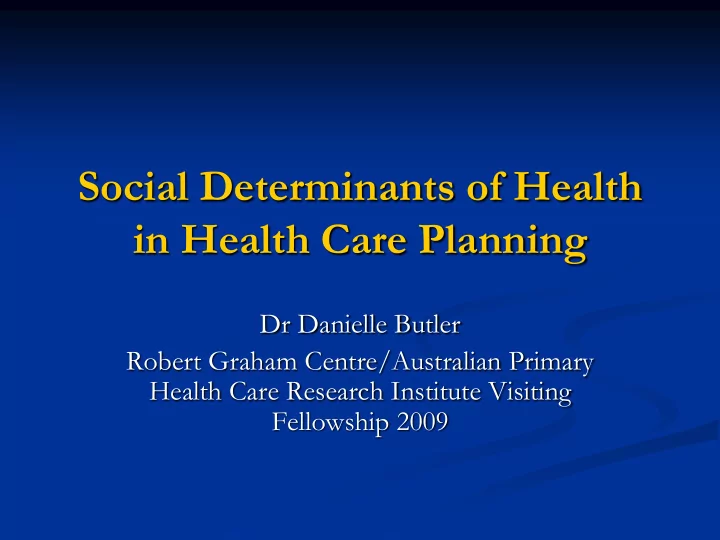

Social Determinants of Health in Health Care Planning Dr Danielle Butler Robert Graham Centre/Australian Primary Health Care Research Institute Visiting Fellowship 2009
Acknowledgements APHCRI Support, guidance and time from Robert Graham Staff The research in this presentation is a project of the Australian Primary Health Care Research Institute, which is supported by a grant from the Australian Government Department of Health and Ageing, under the Primary Health Care Research, Evaluation and Development Strategy. The information and opinions containing in it do not necessarily reflect the view or policy of the APHCRI or the Australian Government Department of Health and Ageing
Background and Policy Context Increasing health and health care access inequity across social gradients between and within countries Need for some measure of this in health planning and resource allocation Australian Health reform Access and equity Primary health care/preventative care Data collection/dissemination/monitoring
Small area measures of social deprivation Captures personal and contextual components UK, NZ, Aust/US Domains Employment, income, social capital, education/skills, barriers to housing and services Use in primary care policy and public health Inherent premise: social deprivation predicts poor health outcomes and health care access. Targeting services to these areas will improve inequity Incentives/funding, benchmarking, public health monitoring Limitations: Ecological fallacy, populations do not always behave as determined by administrative boundaries
Determining need in Australia Current Strategies Workforce shortage and maldistribution a significant concern Current workforce distribution programs based on geographical definitions only (RA) Complex and generous Shortage areas for IMGs only Outer metro for GP trainees
Determining need in Australia The Evidence Utilisation and access to primary health care services relates to: Rurality, age, socioeconomic deprivation, indigenous status and health outcomes Inequity exists along social and remoteness gradients Rural access index for Victoria ( McGrail and Humphreys, 2009) Includes measures of GP supply, geographical distance, mobility, health need and socioeconomic disadvantage Significant heterogeneity within remoteness areas Reliance of geographical definitions alone fails to recognise the diversity of need and inequity of access within areas
GIS and Health in Australia Use of spatial relationships and maps – a powerful tool for understanding health care service issues Enhances understanding of community health needs Immediate visualisation of solutions A common platform for discussion between stakeholders- academia, policy and decision makers, clinician and community Public health information development unit (PHIDU) Practice Health Atlas Rural Access Index HealthLandscape: created an Australian health mapping tool through collaborative fellowship
Inner regional Sydney- Medical workers per 10,000 Orange Bathurst Lithgow Katoomba Yass
Inner regional Sydney- Index of Relative Disadvantage Orange Bathurst Lithgow Katoomba Yass
Sydney-Urban and Outer Metropolitan- Medical Workers per 10,000 Blacktown Parramatta Fairfield Liverpool Sutherland Campbelltown
Sydney-Urban and Outer Metropolitan-Index of Relative Disadvantage Blacktown Parramatta Fairfield Liverpool Sutherland Campbelltown
Top End Australia Index of Relative Disadvantage Medical Workers per 10,000
Quintile of Inner Outer Very Major Remote Total disadvantage Cities Regional Regional Remote 3,482,411 374,710 38,944 4,054 5,652 3,905,771 1 27.83 8.32 1.99 1.12 2.44 19.96 (n=115) (n=21) (n=6) (n=1) (n=2) (n=145) 2,882,745 789,242 183,508 50,722 28,132 3,934,349 2 23.04 17.53 9.36 14.04 12.15 20.11 (n=86) (n=45) (n=17) (n=12) (n=6) (n=166) 2,298,363 1,089,246 440,715 85,170 10,566 3,924,060 3 18.37 24.20 22.47 23.57 4.57 20.05 (n=63) (n=62) (n=55) (n=227) (n=8) (n=215) 1,915,032 1,368,176 523,323 95,938 32,141 3,934,610 4 15.31 30.39 26.68 26.55 13.89 20.11 (n=49) (n=74) (n=69) (n=24) (n=13) (n=229) 1,933,264 880,317 774,686 125,418 154,953 3,868,638 5 15.45 19.56 39.50 34.71 66.95 19.77 (n=46) (n=25) (n=101) (n=38) (n=100) (n=337) 12,511,815 4,501,691 1,961,176 361,302 231,444 19,567,428 Total 100.00 100.00 100.00 100.00 100.00 100.00 (n=359) (n=254) (n=248) (n=102) (n=129) (n=1,092)
Access/Health need score for Australia Constructed score Physician score 1-5 Value of 5 =1:1282-no physicians Rural score 1-5 Disadvantage score 1-5 Combine 3-15 Assumed equal weighting Factor analysis confirmed this assumption Relationship likely more complex than this requires further investigation validation
Avoidable Composite Dis- Risk rate Diabetes Physician Rural Death Percent Deprivation advantage per rate Score Score rate per Indigenous score score 1000 per 1000 100,000 Composite 1.0000 Deprivation 1091 score Physician 0.8219 1.0000 score 1091 1112 Disadvantage 0.8538 0.5282 1.0000 score 1091 1106 1107 0.5554 0.2053 0.3167 1.0000 Rural score 1091 1097 1092 1114 Avoidable 0.5275 0.5397 0.4257 0.2706 1.0000 Death rate 1056 1057 1037 1052 1043 per 100,000 Risk rate per 0.7784 0.8168 0.5191 0.3728 0.6576 1.0000 1000 967 957 940 969 955 967 Diabetes rate 0.4240 0.2710 0.5311 0.0833 0.4888 0.5100 1.0000 per 1000 952 964 964 952 938 964 965 Percent 0.3505 0.1490 0.2568 0.5042 0.7687 0.4047 0.3767 1.0000 Indigenous 1091 1112 1107 1098 1057 967 964 1113 Total -0.1885 -0.0201* -0.0937 -0.4539 -0.1902 -0.0964 0.0767 -0.1989 Population 1091 1112 1107 1098 1057 967 964 1113
Summary Health and health care access vary along social gradients Small area measures of socioeconomic deprivation used internationally This study has created a national composite measure of deprivation predictive of health outcomes and health risk behaviours Can be mapped to enable visualisation of need and hence target resources where needed most Adds to the growing body of evidence of the valuable role of GIS in primary health care research, policy and planning
Questions?
References WHO, 2008, Commission on Social Determinants of Health Final Report http://www.wnmeds.ac.nz/academic/dph/research/socialindicators.html http://www.communities.gov.uk/communities/neighbourhoodrenewal/depr ivation/deprivation07/ http://www.abs.gov.au/websitedbs/D3310114.nsf/home/Seifa_entry_page Krieger et al., (2003) Race/Ethnicity, Gender and Monitoring Socioeconomic Gradients in Health: A comparison of Socioeconomic Measures-The Public Health Disaparities Geocoding Project. American J. Public Health 93(10)1655- 1671 Wang, F., and Luo, W, (2004) Assessing spatial and nonspatial factors for health care access: towards an integrated approach to defining health professional shortage areas. Health and Place 11:131-146 McGrail, M, and Humphreys, H., (2009) The index of rural access” an innovative integrated approach for measuring primary care access. BMC Health Services Research 9:124 Field, K, (2000) Measuring the need for primary health care: an index of relative disadvantage. Applied Geography 20: 305 – 332
Field, 2000
Recommend
More recommend